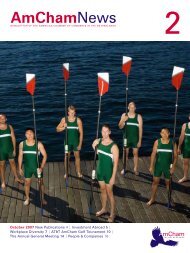Doing Business in the Netherlands 2012 - American Chamber of ...
Doing Business in the Netherlands 2012 - American Chamber of ...
Doing Business in the Netherlands 2012 - American Chamber of ...
You also want an ePaper? Increase the reach of your titles
YUMPU automatically turns print PDFs into web optimized ePapers that Google loves.
<strong>Do<strong>in</strong>g</strong> <strong>Bus<strong>in</strong>ess</strong> <strong>in</strong> <strong>the</strong> Ne<strong>the</strong>rlands <strong>2012</strong><br />
under Customs Control - PCC). This arrangement can, for <strong>in</strong>stance,<br />
be beneficial to <strong>the</strong> pharmaceutical <strong>in</strong>dustry, where base materials, on<br />
<strong>the</strong> one hand, are subject to a relatively high import duty rate. The<br />
processed goods, on <strong>the</strong> o<strong>the</strong>r hand, are generally subject to a zero<br />
rate. Us<strong>in</strong>g <strong>the</strong> Outward Process<strong>in</strong>g Relief (OPR), it is possible to<br />
have products from free circulation <strong>of</strong> <strong>the</strong> EU undergo process<strong>in</strong>g or<br />
treatment <strong>in</strong> third countries and re-import <strong>the</strong>se processed goods <strong>in</strong> <strong>the</strong><br />
EU with a full or partial relief <strong>of</strong> import duties.<br />
20.1 Customs Value and Applicable Customs Rate<br />
Import duties are calculated based on <strong>the</strong> customs value <strong>of</strong> <strong>the</strong> goods<br />
multiplied with <strong>the</strong> applicable tariff rate. The applicable tariff rate<br />
depends on <strong>the</strong> customs classification and <strong>the</strong> (preferential) orig<strong>in</strong> <strong>of</strong><br />
<strong>the</strong> goods.<br />
In order to determ<strong>in</strong>e <strong>the</strong> customs value <strong>of</strong> goods imported <strong>in</strong>to free<br />
circulation, several methods can be used, which have to be applied <strong>in</strong><br />
sequential order. This means that one is allowed to use only a<br />
subsequent customs valuation method if <strong>the</strong> previous method cannot<br />
be applied. The first and most common valuation method is <strong>the</strong><br />
transaction value <strong>of</strong> <strong>the</strong> goods. In this respect, <strong>the</strong> transaction value is<br />
def<strong>in</strong>ed as <strong>the</strong> price actually paid or payable for <strong>the</strong> goods when sold<br />
for export to <strong>the</strong> customs territory <strong>of</strong> <strong>the</strong> EU. It is noted that certa<strong>in</strong><br />
additions or deductions to <strong>the</strong> customs value used may have to be<br />
made depend<strong>in</strong>g on <strong>the</strong> circumstances <strong>of</strong> <strong>the</strong> case at hand. At this<br />
po<strong>in</strong>t <strong>in</strong> time, Dutch customs does currently allow <strong>the</strong> use <strong>of</strong> <strong>the</strong> “first<br />
sale for export” as basis for <strong>the</strong> customs value. This means that an<br />
earlier transaction <strong>in</strong> a cha<strong>in</strong> <strong>of</strong> transaction can be used, usually<br />
result<strong>in</strong>g <strong>in</strong> a lower taxable base. It should be noted that <strong>the</strong> first sale<br />
may be abolished with <strong>the</strong> <strong>in</strong>troduction <strong>of</strong> <strong>the</strong> Modernized Customs<br />
Code well after 2013. However, it is expected that even <strong>the</strong>n, it will<br />
still be possible to use such a transaction as <strong>the</strong> basis for <strong>the</strong> customs<br />
value, albeit that <strong>in</strong> that case <strong>the</strong> buyer <strong>in</strong> that transaction will have to<br />
act as importer <strong>of</strong> record. In general, for valuation purposes a rul<strong>in</strong>g<br />
can be obta<strong>in</strong>ed from <strong>the</strong> Dutch customs authorities. This rul<strong>in</strong>g is<br />
however valid only <strong>in</strong> <strong>the</strong> Ne<strong>the</strong>rlands.<br />
Baker & McKenzie 217





![912.025 AmCham News [1] - American Chamber of Commerce in ...](https://img.yumpu.com/9328612/1/190x127/912025-amcham-news-1-american-chamber-of-commerce-in-.jpg?quality=85)

